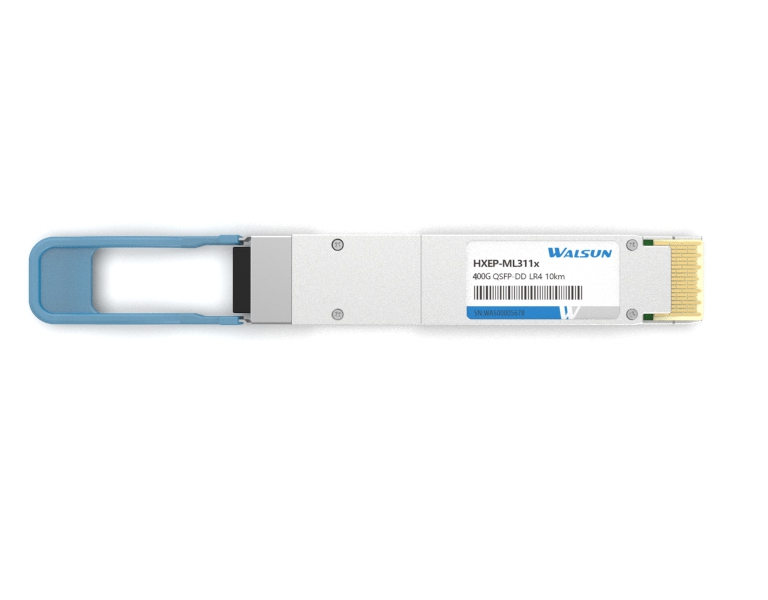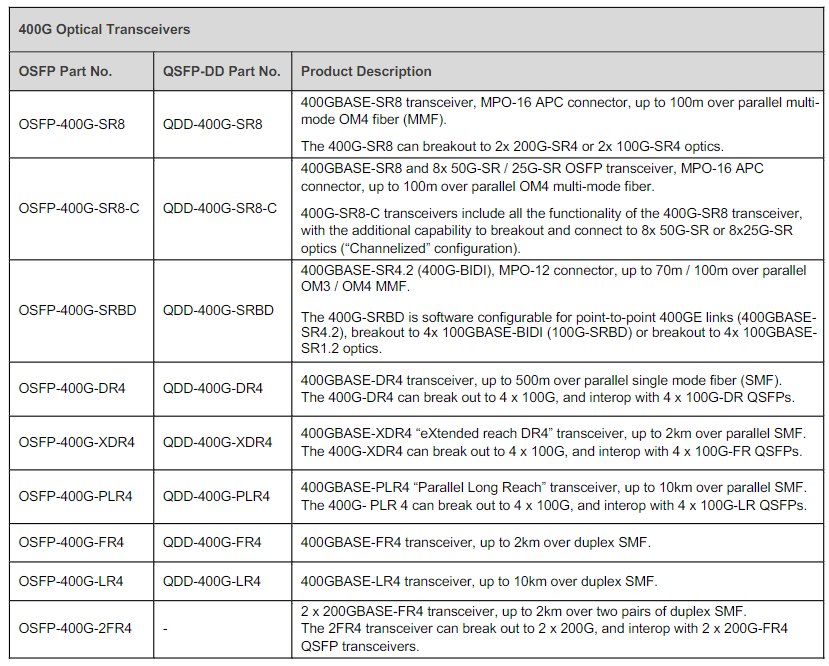

 Industry Dynamic +
Industry Dynamic +  2023.11.01
2023.11.01Table of Contents
What is 400G optical module?
400G optical module refers to the optical module products whose transmission rate reaches 400Gbps. The current mainstream packaging type is QSFP-DD (Quad Small Form-factor Pluggable Double Density), which is a high-speed optical module interface specification, the upgraded version of the QSFP interface, and supports 400G high-speed transmission. Optical fibre is used as the signal transmission medium, by converting digital signals into optical signals and transmitting them in the optical fibre.

400G optical module technology
400G optical module technology mainly includes PAM4 modulation technology, COB packaging technology, DSP digital signal processing technology, microwave integrated circuit technology, high-speed electrical interface technology.
PAM4 modulation technology is the core technology of 400G optical module to achieve high-speed transmission, which uses a 4-level pulse amplitude modulation, the traditional binary digital signal modulation is extended to 4 levels, to achieve a 400G transmission rate.
COB encapsulation technology is a new type of encapsulation technology, which adopts the chip directly welded on the substrate, without the use of encapsulation shell, which can achieve higher signal transmission rate and smaller size.
DSP digital signal processing technology is used in 400G optical modules to achieve signal processing and decoding technology, which can modulate, demodulate and error correction of optical signals and other operations to improve the transmission rate and signal quality of the optical module.
Microwave integrated circuit technology is a high-frequency circuit design technology that can integrate multiple circuits on a single chip to achieve high-speed, low-power, small-size high-frequency circuit design.
High-speed electrical interface technology is a technology for connecting 400G optical modules to external devices, which includes various different interface types, such as 400 QSFP-DD, OSFP, etc., and is used to realise the connection and data transmission between different devices.
400G optical module product classification
According to different specifications and interface types, the product model classification of 400G optical modules mainly includes several types such as SR8, DR4, FR4, LR4, LR8 and ER4.
Among them, SR8 is suitable for short-distance data transmission, DR4 is suitable for medium-distance data transmission, FR4 is suitable for long-distance data transmission, LR4 is suitable for ultra-long-distance data transmission, LR8 is suitable for even longer-distance data transmission, and ER4 is suitable for very long-distance data transmission.

The above are the more common 400G optical module product models on the market at present, with the continuous development of technology, more new models may emerge in the future.
400G optical module application scenarios
400G optical module is suitable for operators' broadband access, broadband network, data centre interconnection, cloud computing and other fields. In the data centre, with the development of cloud computing and big data technology, the scalability, reliability and low-latency requirements for data centres are getting higher and higher, and 400G optical modules can meet these requirements. In addition, 400G optical modules are also suitable for high-speed transmission and long-distance transmission scenarios.
Future Development Direction
The 400G optical module market will continue to grow with the increasing demand from data centres, enterprise networks and telecom operators. With the continuous progress of technology, the cost of 400G optical modules will continue to decline, while the performance will continue to improve. In the future, the application scenarios of 400G optical modules will be further expanded, including IoT, 5G and other fields.
Optical Module Manufacturers
walsun is specialized in delivering optical network solutions. We provide a complete series of optical modules, including 400G QSFP-DD DR4/FR4/LR4/ER4, 100G QSFP28 LR4/ER4/ZR4/BIDI ZR4, 40G QSFP+ ZR4, 25G SFP28 DWDM/CWDM/BIDI, 10G SFP+ DWDM/CWDM/BIDI etc. The modules support multi-vendor configuration, compatible with most OEM devices, such as Cisco, Juniper, Walsun, HPE, Intel, Ubiquiti, etc. Contact us and get a quote now!
Optical Transceiver Overview FAQs
What is the reach, fiber type, connector, and optical modulation for each 400G transceiver type?
The table and block diagrams below summarize the key parameters for the different 400G transceivers supported in Walsun's platforms. Note that in all of the transceivers listed below, the electrical connector interface is always 8 x 50Gb/s PAM-4 (for a total of 400Gb/s). The optical signals however could be 8 x 50Gb/s PAM-4, or 4 x 100Gb/s PAM-4, depending on the type of module. For the modules that have 4 x 100Gb/s PAM-4 optical lanes,a gearbox chip inside the module converts the 8 x 50Gb/s PAM-4 electrical signals (from the board) to 4 x 100Gb/s PAM-4 signals required to modulate the optical signals.
What are the benefits of moving to 400G technology?
Walsun's 400G platforms allow data centers and high-performance computing environments to address growing needs for higher bandwidth at lower cost and power per gigabit. Key benefits include:
1. Increase switching bandwidth by a factor of 4. Migrating from 100G to 400G systems increases the bandwidth per RU from 3.2-3.6T to 12.8-14.4T / RU.
2. Enable higher density 100G ports using optical or copper breakouts. A 32 port 1RU 400G system enables 128 100GE ports / RU. This enables a single Top of Rack (TOR) leaf switch to connect to multiple racks of servers or Network Interface Cards (NICs).
3. Reduce the number of optical fiber links, connectors, and patch panels by a factor of 4 when compared to 100G platforms for the same aggregate bandwidth.
4. Enable 2-4X lower cost and power / bit, reducing capex and opex.
What form-factors are used for 400G optics and cables?
There are two form-factors defined for 400G optical modules and cables:
1. The OSFP: The OSFP stands for "Octal Small Form-factor Pluggable". It is described as an "Octal"module because the electrical interface of an OSFP connector consists of 8 electrical lanes, running at 50Gb/s each, for a total of bandwidth of 400Gb/s.
2. The QSFP-DD: The QSFP-DD stands for "Quad Small Form-factor Pluggable (QSFP) – Double Density(DD)". The electrical interface of a QSFP-DD connector also has 8 electrical lanes, running at 50Gb/seach, for a total bandwidth of 400Gb/s. The QSFP-DD form factor is similar to the QSFP form factor,except a second row of electrical contacts has been added to increase the number of high-speed electrical lanes from 4 (in a QSFP) to 8 (in a QSFP-DD).
What 400 form-factors does Walsun support?
Walsun supports both OSFP and QSFP-DD form-factors – i.e. Walsun 400G platforms will be offered in both OSFP and QSFP-DD variants (a detailed comparison of OSFP and QSFP-DD form factors is contained later in this document).
Can I plug an OSFP module into a QSFP-DD port, or a QSFP-DD module into an OSFP port?
No. The OSFP and the QSFP-DD are two physically distinct form factors. If you have an OSFP system, then OSFP optics and cables must be used. If you have a QSFP-DD system, then QSFP-DD optics and cables must be used.
Can I have an OSFP on one end of a 400G link, and a QSFP-DD on the other end?
Yes. The OSFP and QSFP-DD describe the physical form factor of the module. As long as the Ethernet media types are the same (i.e. both ends of the link are 400G-DR4, or 400G-FR4 etc.), OSFP and QSFP-DD modules will interop with each other.
Subscribe to the newsletter
for all the latest updates.
2-5# Building, Tongfuyu Industrial Zone, Aiqun Road, Shiyan Street, Baoan District, Shenzhen. China
